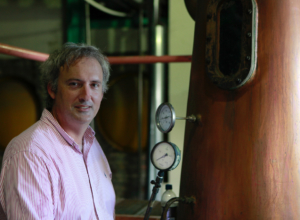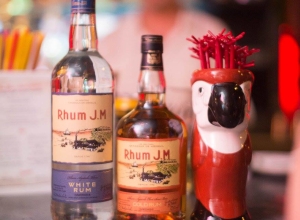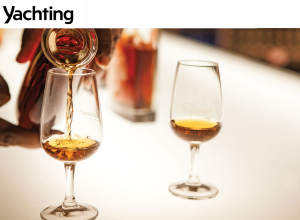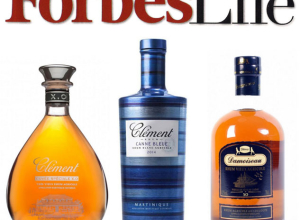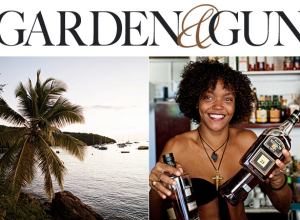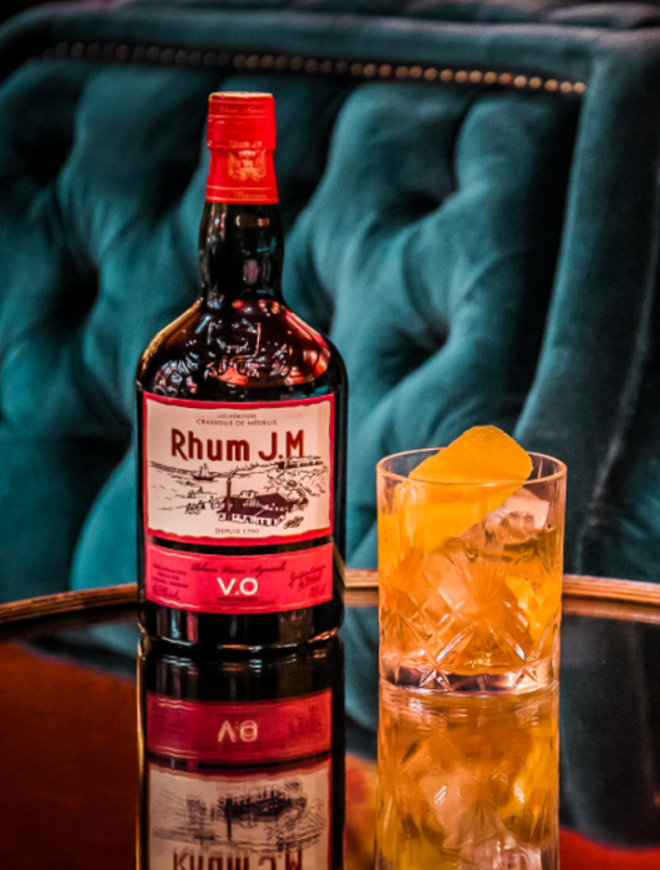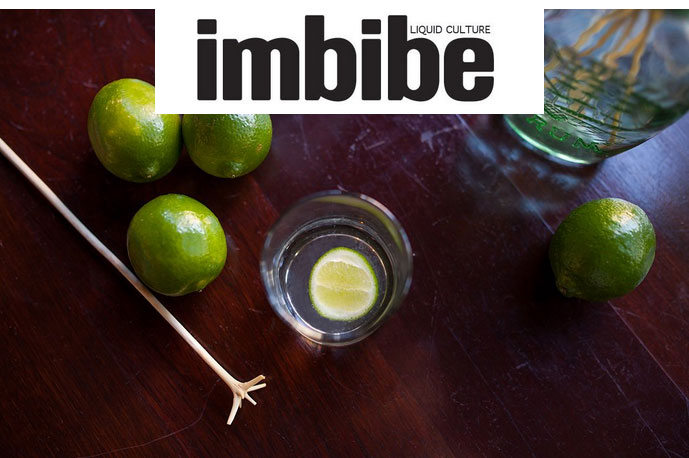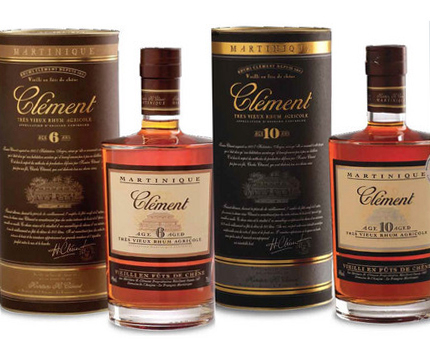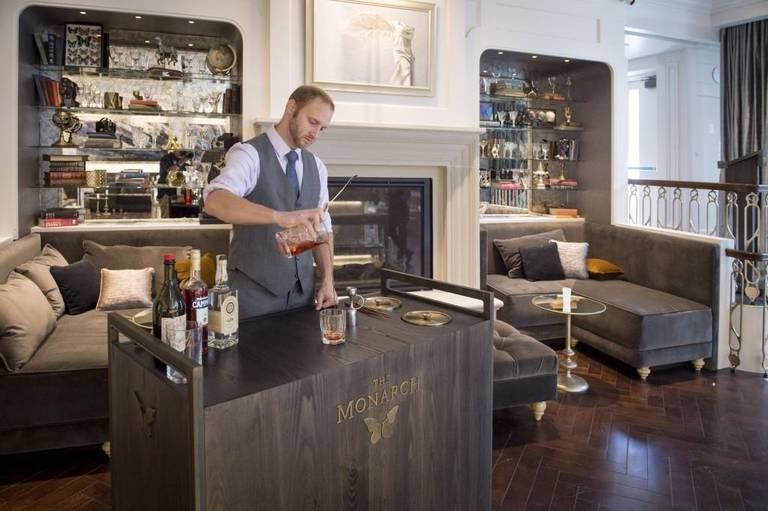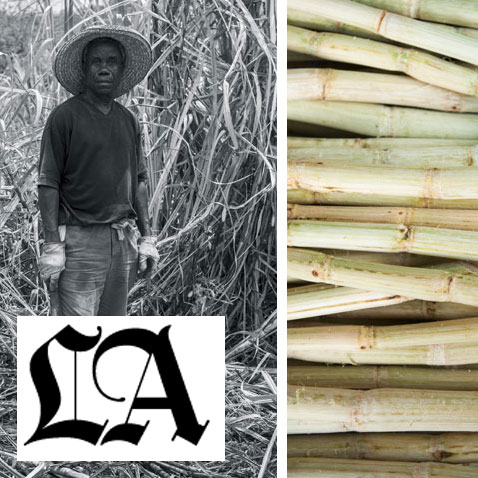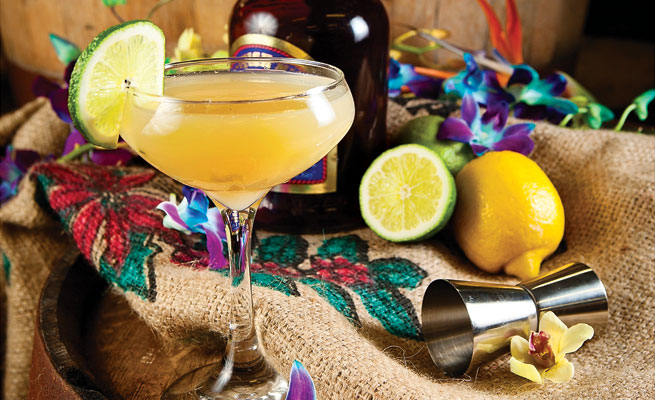
Outside the Grocery, the late afternoon sun shone down from a cloudless sky, but inside the Cannon Street restaurant a storm was brewing.
Fortunately, it was contained within a single short-stemmed glass, the bottom half holding a white layer of ginger beer so thick and cloudy that it almost looked like cream. Above it hung a dark band of Kraken Black Spiced Rum, looking as dark and ominous as thunderheads rolling in from over the sea.
The drink was so lovely it seemed almost disrespectful to stir it, but I stirred it anyway, the thin plastic straw swirling the black and white layers into a uniform caramel-colored whole. I took a short sip. It was sweet and slightly fizzy, tinged with vanilla but with a strong prickly ginger bite coming through at the end.
“Bourbon be damned,” I thought as I took a second sip. “It’s time to return to rum.”
The New Spirit of Charleston
In a New York Times piece back in April, Matt and Ted Lee memorably characterized Charleston as “a town afloat on bacon-washed bourbon,” but thankfully that culinary trend already seems to be fading.
As I sipped my Grocery Storm at the Grocery bar, I asked Kevin Johnson, the restaurant’s chef/owner, what ingredients were getting him excited these days. He didn’t mention bacon or belly or any other part of the pig. “I’m really much more interested in fish and vegetables right now,” he admitted.
That echoed what I’d been hearing from other chefs like Mike Lata of the Ordinary. Back in January, he explained the concept of his fancy seafood and oyster house as a way of heading away from the whole “lardcore” thing. “Seafood has been kind of forgotten in the wake of pork,” he told me. “But how much charcuterie and pork fat do you need?”
If there’s more to Southern cooking than bacon, there’s far more to Southern drinking than bourbon. The rising passion for pristine local fish links Charleston’s cuisine ever more closely to its most valuable natural resource: the sea. Rum, which itself is closely tied to the ocean and to Charleston’s history, is the perfect accompaniment.
Brooks Reitz, the general manager of the Ordinary, agrees. Instead of a long list of pricey bourbons, the Ordinary features a dozen good rums on the drink board behind the bar. They include fine sipping spirits, like 8- and 15-year-old Barbancourt Rhum Agricole, as well as stiff old pirate juice like Smith & Cross. “People see that list and get excited and interested,” Reitz says. “It’s something new for the city. When you’ve got so much bourbon in town, it’s fun to experiment.”
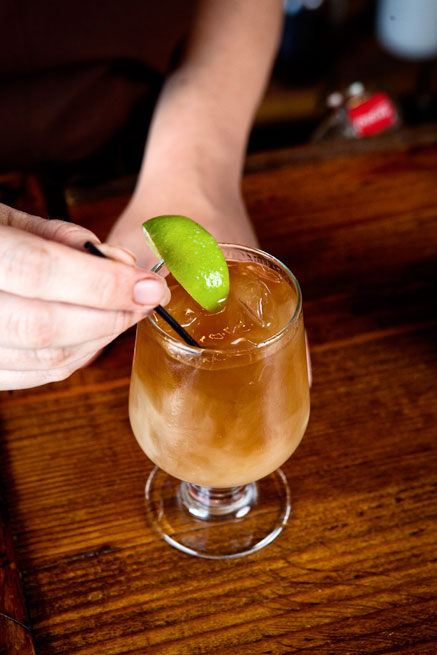
Jonathan Boncek
Go Hogo
It’s taken a long time for rum to get this kind of respect. It still suffers from decades of indignity in the form of slushy frozen “daiquiris” laden with sugar and fruit. Television ads featuring the hijinks of 20-something punks with a little Captain in them have done little to bolster rum’s image as a serious spirit.
I got over the girl in a month or two, but my aversion to rum’s sharp sugary flavor took more than a decade to subside. I’m glad that it did though, for rum is perhaps the most diverse and intriguing of the hard spirits.
The differences between one variety of bourbon and the next are fairly subtle. Not rum. In color, it can range from crystal-clear through degrees of amber all the way to inky black. There’s a full spectrum of flavors, too. Spiced rums like Sailor Jerry and Captain Morgan infuse amber spirits with everything from cinnamon and cloves to rosemary and black pepper. Malibu Coconut Rum was an early pioneer in the flavored category, and today you can buy rums tinged with everything from bananas to passion fruit.
There are high-end connoisseur rums too, which can be sipped in a snifter like the finest cognac. Barbancourt’s buttery Rhum Agricoles hail from Haiti and are distilled from pure sugar cane juice and aged in oak barrels for up to 15 years. I’m especially partial to Ron Zacapa XO, a Guatemalan rum aged in a succession of whiskey, sherry, and cognac barrels in a special solera over a mile above sea level. It has so many chocolate, vanilla, and fruit notes that it will send you running for a thesaurus just to describe it.
But as delightful as such high-toned rums are, my favorite varieties don’t try to imitate bourbon or cognac but rather take things in a different old-school direction, to a place where the brown liquors can’t follow.
In other words, they go hogo.
It has nothing to do with pigs. It’s a West Indian corruption of the French haut goût (“high taste”), which was often used to describe rotting meat. When applied to rum it meant, as one 19th century commentator put it, “the strong and somewhat offensive molasses-like flavor of new rum.”
Rum got its start as a way to make something useful out of the byproducts of the sugaring process — the “scummings” that floated to the top of the cauldrons as the cane juice was boiled, the dark, sticky molasses that oozed from the sugaring pots, even the water used to clean the pots after boiling. Left out in the tropical heat, it would soon be bubbling and fermenting from natural yeasts. And they could put that fermented mess into a still and transform it into hard spirits.
Originally, rum was made in pot stills, inefficient devices that left lots of impurities in the finished product. In the 20th century, Caribbean rum-makers shifted to modern, more efficient column stills, but during rum’s heyday in the colonial era it was raw, harsh stuff.
When you talk to rum fans about these hogo-rich varieties, words like “funky” and “stinky” quickly find their way into the conversation. They mean it in the very best way, in the way that gamey meat and stinky cheese can be a good thing. In cocktails, that stinkiness provides power — bold, assertive flavors that a clever bartender can do a lot with.
Pusser’s Comes to Town
Charleston has had its own line of high-quality rums for a couple of years now, thanks to Wadmalaw’s Firefly Distillery, whose Sea Island Rum line includes aged gold, coffee-infused, and spiced varieties. This February, Charleston gained its own locally based brand of old-style hogo rum too, when Pusser’s Rum moved its corporate headquarters here from the British Virgin Islands.
The company’s name is a corruption of “purser,” the officer in charge of a ship’s stores. Anything that is “purser’s issue” is something official in origin, and until 1970 the Royal Navy officially issued rum to its sailors as part of their daily rations.
Around 1970, the Brits finally realized that having tipsy sailors operating high-tech naval weaponry might not be the best of ideas. On July 31 of that year, an occasion dubbed “Black Tot Day,” the Royal Navy issued its last official dose of rum, ending a three-centuries-old tradition.
Nine years later, a sailor and raconteur named Charles Tobias secured the Admiralty’s formula and launched Pusser’s Rum. Their product is a blend of five rums from different distilleries in Guyana and Trinidad that are combined following the British Navy’s time-proven formula. The majority of the rum is distilled in old-school pot stills, two of which were fashioned from Amazon greenwood and first put into service in the 1700s. Though it is tempered somewhat by smoother column-stilled spirits, the finished product still has a hearty dose of old hogo — a sharp, vegetal bite that underlies the rum’s caramel sweetness.
Vendors like Pusser’s have discovered a great way to win bartenders and imbibers over to their pot-still rums: market a signature cocktail that’s hard not to like. For Pusser’s, that cocktail is the Painkiller. The drink was reputedly invented by Daphne Henderson, the proprietor of the six-seat Soggy Dollar on Jost Van Dyke in the British Virgin Islands. If you want to try a Painkiller for yourself, you should have no problem tracking one down in Charleston this month. Pusser’s has organized a month-long “Painkillers on the Peninsula” promotion, with some 21 restaurants participating.
I stopped by Blossom, the headquarters for the promotion, to give one a shot. The bartender shakes together a generous dose of Pusser’s along with pineapple juice, orange juice, and cream of coconut, then pours the frothy mixture over ice in a tall rocks glass. It’s the kind of drink that really demands a hogo-rich rum. The citrus and coconut give it a smooth, sweet body, but the Pusser’s still punches right through the sweetness of the pineapple and coconut and gives it a lingering bite that’s accented beautifully by the dusting of freshly ground nutmeg over the top.
This ability to complement savory spices is one of the most remarkable characteristics of big, stinky rums. The Dark and Stormy, of which the Grocery’s beautifully layered cocktail is a variation, is a perfect example. The formula couldn’t be simpler: fill a glass with ice, pour over about six ounces of ginger beer, and top with a generous pour of dark rum.
To be a proper Dark and Stormy, it must be made with Gosling’s Black Seal. A Bermuda rum blended from pot-still and column-still spirits, Gosling’s is aged in once-used charred oak whiskey barrels, which gives it its distinctive crude oil hue. Drunk straight, Gosling’s has an earthy and slightly burnt flavor, but when you mix it with spicy ginger beer, the rum opens up and becomes a complex, soothing blend of spices.
When it comes to Painkillers and Dark and Stormys, one must be particular about the brand of rum used. A cocktail recipe can’t be copyrighted, but its name can be trademarked. Both Pusser’s and Gosling’s have done just that for their signature cocktails, and they’re pretty diligent in enforcing those trademarks too. If you’re making a Painkiller with something other than Pusser’s, watch the mail for your cease and desist letter. Gosling’s will let you slide on the ginger beer. Barritt’s, a Jamaican brand, has long been the traditional mixer, but Gosling’s now markets its own version, too. But the rum better be Black Seal.
The folks at Fiery Ron’s Home Team Barbecue stumbled over Pusser’s trademark when they created their own Painkiller variation. Instead of Pusser’s, they use gold Admiral Nelson and 93-proof Sailor Jerry spiced rum, and they pour it all in a big SaniServ freeze mixer and whirl it into a slushy frozen drink.
When they learned that calling it a Painkiller would get them in the dog house, they went about correcting the situation in a most democratic way, inviting customers to propose new names and letting the public select their favorite online. Trey Rust came up with the winning moniker, “Gamechanger,” and he was rewarded for his efforts with free barbecue every week for a year.
Instead of a creamy white, Home Team’s version is bright yellow in color, and it’s an interesting experiment in the effect of hogo versus spice. In a traditional Painkiller, the funk of the Pusser’s powers through the citrus and coconut. In the Gamechanger, the orange juice papers over the spiced rum’s flavors, leaving you with an easy-sipping frozen beverage carrying a sneaky cargo of liquor. Sip it too fast through a straw, and it can lay you low with a crippling brain freeze. Sip one too many, and that hidden dose of rum may well end up changing your entire game plan for the evening.
The Dark and Stormy lends itself to experimentation too. At Sesame, they mix up a “Black and Stormy” that uses Gosling’s ginger beer but twists up the rum with Malibu Black, which adds pleasant coconut notes to the cool gingery mix.
At the Grocery, bartender Hallie Arnold spices up what she’s dubbed the Grocery Storm with a dose of triple-spiced housemade ginger beer. “We puree fresh ginger, steep it with dried ginger, and mix in candied ginger,” Arnold says. “Then we put it through a blender, sweeten it with falernum [a spiced Caribbean syrup] and mix it with soda.” That triple-ginger bite is the key: it gives the drink a rich, exotic flavor that makes one long for the islands.
To the Sea
Rum’s association with the ocean is long and enduring, and not just because of those British sailors and their daily tot. For three centuries, rum has been the spirit of choice for those who sail the Carolina waters, from the sailors who delivered cargos to the Charleston docks to the pirates who preyed upon their ships.
Modern day adventurers still prize rum, too. This month witnesses the return of the Charleston Bermuda Race, a yachting event that occurs every two years. Competitors will depart Charleston on May 17 and race to the Royal Bermuda Yacht Club in Hamilton, Bermuda, a journey of at least six days.
When they arrive, they may well reward themselves with the club’s signature rum cocktail. If you’re not up to sailing all 777 miles to Bermuda to sample one, you could simply head down to the Ordinary, where a drink called the Royal Bermuda Yacht Club (RBYC) is one of the features of the rum-centric cocktail menu.
The RBYC starts with Mount Gay Rum, Velvet Falernum, and lime juice. While most recipes call for a couple of dashes of Cointreau, at the Ordinary they substitute Creole Shrubb, a rum-based orange liqueur from the island of Martinique. It’s a delicate, balanced cocktail, miles away from the heavy-handed sweetness of the old frozen daiquiri days.
Mount Gay is a relatively light-bodied spirit, but in proper hands even an old hogo rum like Smith & Cross can be transformed into a thing of delicate beauty. A recreation of the style of rum that was prevalent in Jamaica a century ago, it’s a blend of two pot-stilled Jamaican rums made from the full range of sugaring byproducts — molasses and skimmings and syrup bottoms, too. For good measure, it’s bottled at a stiff “Navy strength” of 114 proof.
A straight sip of Smith & Cross will curl your toes, but in the Ordinary’s Zissou cocktail it undergoes a remarkable transformation.
“Everything here we’ve tried to keep streamlined,” Brooks Reitz explains. The high-proof rum is cut with lime juice and two very unlikely liqueurs, elderflower and maraschino, resulting in a pale yellow cocktail that’s served in a simple but elegant coupe glass garnished with nothing but a touch of white foam around the edges.
“Once you add the citrus and you shake it, you get that great sweetness. Plus, maraschino has a dry character that really goes well with the stiff rum,” Reitz says. Atop it all, the elderflower liqueur adds light, floral notes that blend wonderfully. It’s a splendid example of how a heavy, old hogo rum can be incorporated into a subtle and complex cocktail.
Further evidence can be found at the Gin Joint, where they blend not two, not three, but five different rums into a splendid cocktail called the Jamaican Old Fashioned. Hogo-rich Smith & Cross merges with three long-aged rums — Flor de Caña Grand Reserve, Pampero Aniversario, and 12-year-old Zaya Grand Reserva — along with a big kick of 126-proof Wray & Nephew Overproof rum. Finished with coffee elixir, a little raw sugar, and Angostura bitters, the Jamaican Old Fashioned is a dark, complex sea of subtle flavors and a perfect illustration of rum’s mixing power.
This complex palate of flavors makes old-school pot-stilled rum a cocktail tinkerer’s dream, and local bartenders are really just getting started with their explorations of its potential. The initial results are encouraging, and perhaps before the year is out, when all those visiting foodies and New York media muck-a-mucks come to the Holy City to sample our local delicacies, they won’t be seeking out shrimp and grits or fried green tomatoes but rather a whole roasted grouper and a plate of ice-cold Caper’s Blades.
And to get the evening started? “Well, we’re in Charleston,” you’ll hear them say. “We better order something with rum in it.”
Read The Full Article Here
div id=”google_ads_div_Food-Drink_Interstitial_ad_wrapper”The company’s name is a corruption of “purser,” the officer in charge of a ship’s stores. Anything that is “purser’s issue” is something official in origin, and until 1970 the Royal Navy officially issued rum to its sailors as part of their daily rations.

